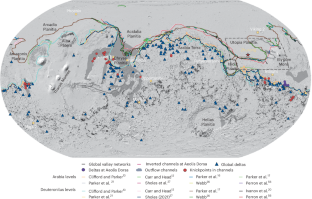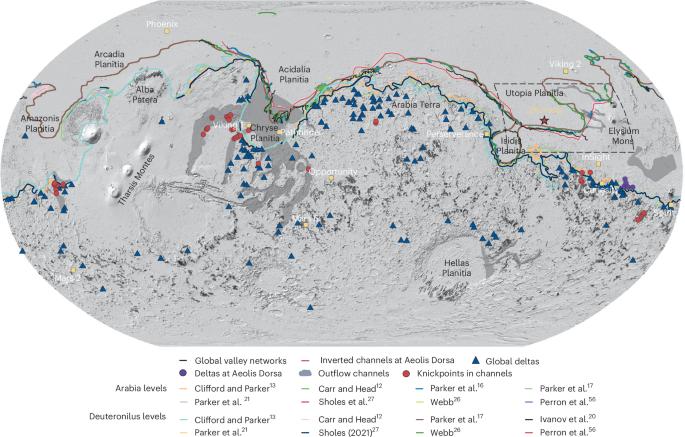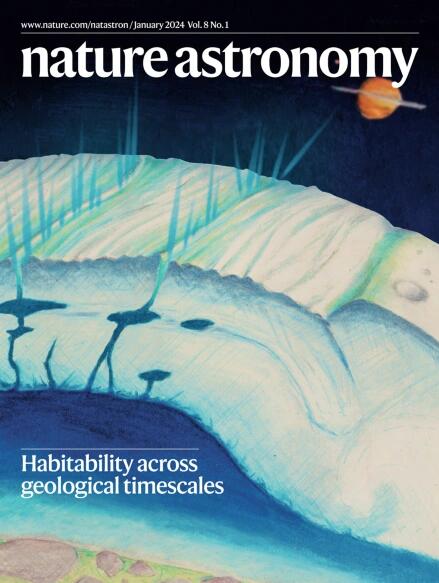Hypothesis of an ancient northern ocean on Mars and insights from the Zhurong rover
IF 12.9
1区 物理与天体物理
Q1 ASTRONOMY & ASTROPHYSICS
引用次数: 0
Abstract
Various landforms suggest the past presence of liquid water on the surface of Mars. The putative coastal landforms, outflow channels and the hemisphere-wide Vastitas Borealis Formation sediments indicate that the northern lowlands may have housed an ancient ocean. Challenges to this hypothesis are from topography analysis, mineral formation environment and climate modelling. Determining whether there was a northern ocean on Mars is crucial for understanding its climate history, geological processes and potential for ancient life, and for guiding future explorations. Recently, China’s Zhurong rover has identified marine sedimentary structures and multiple subsurface sedimentary layers. The unique in situ perspective of the Zhurong rover, along with previous orbital observations, provides strong support for an episodic northern ocean during the early Hesperian and early Amazonian (about 3.6–2.5 billion years ago). The ground truth from future sample-return missions, such as China’s Tianwen-3 or the Mars sample-return programmes by NASA, ESA and other agencies, will be required for a more unambiguous confirmation. This Perspective presents the evidence in favour of and against the existence of an ancient ocean covering the Martian northern plains (Vastitas Borealis), discussing in particular the contribution of the Chinese Zhurong rover observations in supporting the presence of an ocean and the key role of the upcoming sample return.


火星北部古代海洋的假设和 "祝融 "号探测器的启示
各种地貌表明火星表面曾经存在液态水。推测的海岸地貌、外流通道和覆盖整个半球的 Vastitas Borealis Formation 沉积物表明,北部低地可能曾有一个古老的海洋。对这一假设的质疑来自地形分析、矿物形成环境和气候建模。确定火星北部是否存在海洋对于了解火星的气候历史、地质过程和远古生命的潜力以及指导未来的探索至关重要。最近,中国的 "祝融 "号探测器确定了海洋沉积结构和多个地下沉积层。祝融号探测器独特的原位视角,加上之前的轨道观测,为早期黑斯伯纪和早期亚马逊纪(距今约36-25亿年)北方海洋的形成提供了强有力的支持。未来的取样返回任务,如中国的天文三号或美国宇航局、欧空局和其他机构的火星取样返回计划,将需要地面实况来进行更明确的确认。
本文章由计算机程序翻译,如有差异,请以英文原文为准。
求助全文
约1分钟内获得全文
求助全文
来源期刊

Nature Astronomy
Physics and Astronomy-Astronomy and Astrophysics
CiteScore
19.50
自引率
2.80%
发文量
252
期刊介绍:
Nature Astronomy, the oldest science, has played a significant role in the history of Nature. Throughout the years, pioneering discoveries such as the first quasar, exoplanet, and understanding of spiral nebulae have been reported in the journal. With the introduction of Nature Astronomy, the field now receives expanded coverage, welcoming research in astronomy, astrophysics, and planetary science. The primary objective is to encourage closer collaboration among researchers in these related areas.
Similar to other journals under the Nature brand, Nature Astronomy boasts a devoted team of professional editors, ensuring fairness and rigorous peer-review processes. The journal maintains high standards in copy-editing and production, ensuring timely publication and editorial independence.
In addition to original research, Nature Astronomy publishes a wide range of content, including Comments, Reviews, News and Views, Features, and Correspondence. This diverse collection covers various disciplines within astronomy and includes contributions from a diverse range of voices.
 求助内容:
求助内容: 应助结果提醒方式:
应助结果提醒方式:


